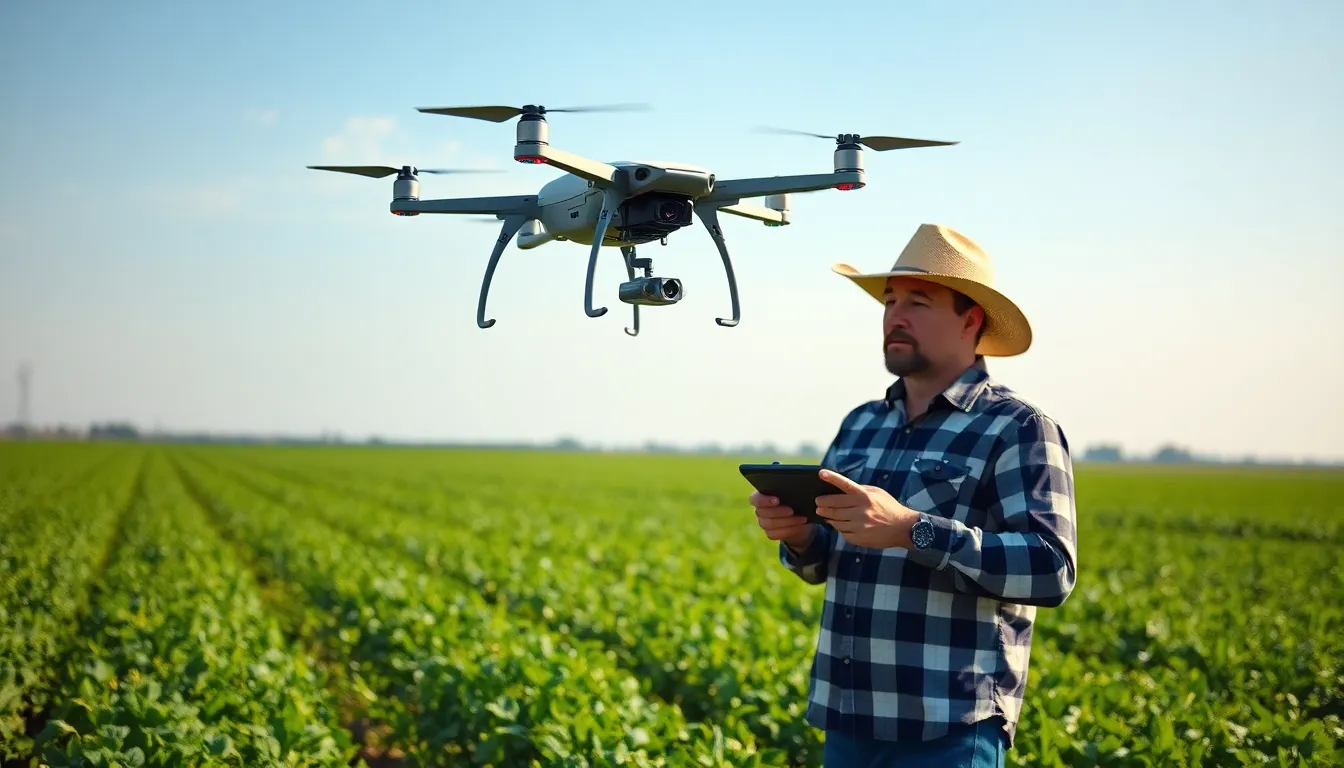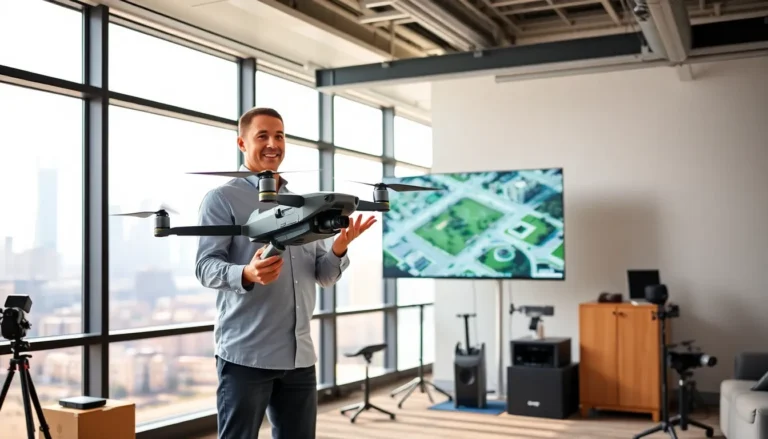Drones have come a long way from just being fancy toys for tech enthusiasts. Now, they’re the high-flying heroes of various industries, delivering everything from medical supplies to your favorite pizza. Imagine a world where your dinner arrives via drone—talk about a delivery that really takes off!
But it’s not just about convenience; drones with payloads are revolutionizing how we approach logistics, agriculture, and even disaster relief. These aerial marvels can carry significant weight while navigating tricky terrains, making them indispensable tools for businesses and communities alike. Buckle up as we explore the exciting potential of payload-carrying drones and how they’re changing the game in ways you never thought possible.
Table of Contents
ToggleOverview of Drones With Payloads
Drones with payloads represent a significant advancement in unmanned aerial vehicle technology. These devices transport various materials, including medical supplies, food, and equipment, directly to their intended destinations. Their ability to access hard-to-reach areas has increased their popularity in industry sectors such as logistics, agriculture, and emergency response.
Payload capacities vary greatly among different drone models. Some lightweight drones can carry payloads weighing as little as 0.5 pounds, while larger commercial models may handle up to 50 pounds or more. This versatility enables operators to select drones based on specific job requirements. For instance, delivering small packages requires smaller, more nimble drones, whereas agriculture might benefit from larger drones equipped with sensors and fertilizers.
Application areas expand as industries embrace payload-carrying capabilities. In logistics, companies use drones to expedite deliveries, reducing transport times from days to minutes. Agricultural sectors leverage drones for crop monitoring and pesticide distribution, improving yield efficiency. Emergency responders utilize drones to deliver medical supplies or aid to remote locations, enhancing emergency response effectiveness significantly.
Regulations impact operational dynamics within this space as well. The Federal Aviation Administration (FAA) governs how drones operate within the national airspace system, ensuring safety while allowing innovation. Compliance with these regulations enables businesses to implement drone technology effectively while maintaining public safety.
Innovation continues to drive advancements in drone payload technology. Development efforts focus on enhancing battery life, expanding payload capacities, and integrating autonomous navigation systems. As these technologies evolve, the potential applications for drones carrying payloads will only expand further, promising to revolutionize operations across various sectors.
Types of Drones With Payloads

Drones capable of carrying payloads come in several distinct types, each suited for specific applications. Understanding these types helps operators select the right model for their needs.
Fixed-Wing Drones
Fixed-wing drones excel in long-distance travel and efficient energy use. These models feature a traditional airplane design, enabling extended flight times and greater distances. Payload capacities often reach up to 200 pounds, allowing transport of larger items, such as agricultural supplies or survey equipment. Suitable for mapping and monitoring tasks, they gather data across vast areas. Their design provides stability during flight, making them advantageous for ground imaging and long-duration missions.
Multirotor Drones
Multirotor drones, including quadcopters and hexacopters, dominate the market for payload versatility. These models feature rotating blades that provide excellent maneuverability in confined spaces. Payload capacities generally range from 2 to 50 pounds, making them ideal for tasks like delivering medical supplies or packages. Operators appreciate their vertical takeoff and landing capabilities, which facilitate usage in urban environments. Additionally, multirotor drones often incorporate advanced sensors, enhancing their functionality for agriculture and surveillance applications. Their design allows for quick deployment, maximizing operational efficiency.
Applications of Drones With Payloads
Drones with payloads serve a variety of important functions across multiple sectors. Their growing popularity stems from the efficiency and convenience they provide.
Commercial Uses
Drones play a crucial role in commercial applications. In logistics, companies use them for quick deliveries of small packages, significantly reducing shipping times. Retailers increasingly rely on drones to transport goods directly to customers, enhancing satisfaction. Additionally, drones improve agricultural practices by monitoring crops and distributing fertilizers or pesticides, resulting in increased yields. Real estate professionals utilize drones to capture aerial imagery, showcasing properties from unique angles. Industries are now beginning to explore drone capabilities for inventory management and surveillance.
Military Uses
Drones have transformed military operations significantly. They serve as reconnaissance tools, providing real-time data without risking personnel. Surveillance missions benefit from drones’ ability to gather intelligence over vast areas, allowing for improved strategic planning. Cargo delivery is another vital application for military drones, transporting supplies to remote or dangerous locations. Drones equipped with sensors aid in search and rescue operations, ensuring distances covered are efficiently managed. The military sector continues to invest in drone technology, leading to innovations that enhance operational effectiveness.
Key Features to Consider
When selecting drones with payloads, understanding specific features significantly impacts their effectiveness. Key considerations include weight limitations and flight time and range.
Weight Limitations
Weight limitations play a critical role in drone operation. Different models accommodate varying payload capacities, impacting their suitability for specific tasks. Smaller drones excel in handling up to 30 pounds, ideal for lightweight deliveries. Larger drones, such as fixed-wing models, manage capacities as high as 200 pounds, making them suitable for transporting heavy equipment or multiple packages. Ensuring the payload remains within specified limits increases safety and efficiency during flight.
Flight Time and Range
Flight time and range are essential performance metrics of payload-carrying drones. Drones typically achieve flight durations ranging from 20 minutes to several hours, depending on battery capacity and overall weight. A flight time of 30 minutes may suffice for short deliveries, while longer missions benefit from drones with extended ranges exceeding 10 miles. Understanding these specifications allows operators to match drone capabilities to operational demands, ensuring timely and effective delivery of payloads.
Drones with payloads are reshaping how industries operate by providing innovative solutions for logistics agriculture and emergency response. Their ability to navigate challenging environments and deliver essential supplies enhances efficiency and effectiveness across various sectors.
As technology continues to advance the capabilities of these drones the potential for new applications is vast. Operators can select models based on specific needs ensuring that payload capacities and flight times align with operational requirements.
With ongoing regulatory developments and technological improvements the future of payload-carrying drones looks promising. They’re set to play an even more significant role in transforming industries and improving service delivery in the years to come.





